
Für eine deutsche Übersetzung dieser Seite einfach die Brandenburger Flagge anklicken
 |
Click the Brandenburg Flag for a German translation Für eine deutsche Übersetzung dieser Seite einfach die Brandenburger Flagge anklicken |


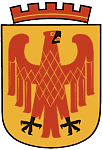 |
Home Towns - Potsdam, GermanyThe Old Market Square Saint Nicholas Church |
 |


 |
This site is part of our Old Market Square page, which is part of our Potsdam, Germany site. Click the left turn sign to return to the Old Market Square site or the u-turn sign to get back to our Potsdam Start Site. |

|


 |
The Church of Saint Nicholas is without a doubt the most dominant building at the square. Construction of the
church we see today started in 1830, but this has been holy ground for a lot longer than that. For the last 700
years, the only constant about this church is change and when we were there in 2007, it was once again under
construction. but when we returned in 2010, we could enjoy it in all its glory.
 The first church in this place was most likely a cobblestone-built church first mentionened in 1317 as "Church of St. Mary." In 1375, the registry of Holy Roman Emperor Charles IV records this church in a simple drawing, showing a Romanesque Basilica. Later, it was transformed into a Gothic hall church. This Catholic church was under the supervision of the Spandau priory until 1539, when Elector Joachim II. Hector introduced the Reformation into the Brandenburg Margraviate.  The first documented mentioning of the change of confession dates back to 1602, when Elector Joachim Frederick made St. Katherine, namesake of his dead wife Katharina, the patron saint of the town and dedicated the gothic church to her. Front of St. Nicholas Church, picture borrowed from wikipedia |

| In the 1700s, Potsdam became a real town and the small gothic church of was soon too small for the growing congregation. In 1721, the old Church of St. Katherine was dismantled and in 1724 it was replaced by a new Baroque church with a steeple as high as 278 feet, designed by architect Philipp Gerlach. By request of King Frederick William I, the church was dedicated to Saint Nicholas, patron saint of sailors and merchants. |


|
King Frederick William I, also known as the Soldier-King didn't care much about representation and – in
order to save money for his army – architecture during his reign was rather frugal. On the other hand, his son, King
Frederick II, also known as the
Philosopher on the Throne, worked so hard on beautifying his residence, that this time period in
architecture was later called Frederician
Rococo. He ordered new facades in front of many buildings, giving the downtown area a palace like apparel.
Citizen called the facades, rather disrespectfully,
shirtfronts.
 For the Old Market Square, bordered by St. Nicholas, the old City Hall and the City Palace, the King aspired an Italian attire. In 1755, a forefront, modeled after Rome's largest church, the Basilica di Santa Maria Maggiore and a roman obelisk were erected in front of the church. both were designed by architect von Knobelsdorff shortly before his death in 1753. St. Nicholas Church with "Shirtfront," 1773 |

Forty years later, on September 3, 1795, the church burned down completely during reconstruction work, but the
"shirtfront" remained in place until 1811. Immediately after the fire, King
Frederick William II,
successor of Frederick the Great, ordered a reconstruction. However, it
took 37 years, until the parish of St. Nicholas again had a place for worship.
 Within less than a year, two architects, Michael Philipp Boumann and Friedrich Gilly had a proposal for reconstruction ready to go but fait has other plans. Within the next six year, first the King and then both of his architects died before they could start working on their plans. Shortly after that,in 1806, Prussia lost the decisive battle of Jena-Auerstedt and Napoleon conquered Prussia, making Potsdam the main depot for his cavalry. For the next couple of years, Potsdam had to feed French soldiers and horses, and there was no money to rebuild a church. |

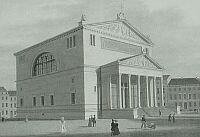 St. Nicholas after reopening in 1838  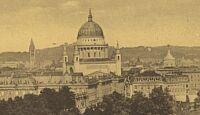 St. Nicholas with Schinkel's Dome, 1914 |
Finally, in 1826, plans were made to rebuild the lost church.
Karl Friedrich Schinkel,
the greatest architect of his time enhanced the plans made by his teacher
Gilly 40 years earlier and designed a church crowned with a dome; modeled after the
Panthéon in Paris and St. Paul's Cathedral in London. But his top-client, King Frederick William III insisted in something totally different – a basilica without any dome or steeple. Construction started on September 3, 1830, exactly 35 years after the fire. On September 17, 1837, the congregation of St. Nicholas had its church back.
In 1840, King
Frederick William IV
became King. The "Romantic on the Prussian Throne" was fond of Schinkel's original plan, but
the great architect died in 1841 and never saw his vision becoming reality. In 1843, the King ordered architect
Friedrich Ludwig Persius to fulfill
Schinkel's legacy. Persius got to work, but only to become the church's fourth architect who died without finishing
his plans. After Persius' death in 1845, architect
Friedrich August Stüler finished the task.
|


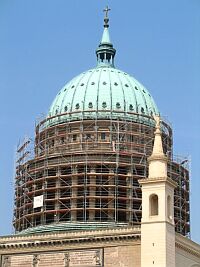 |
Basically, St. Nicholas has been under construction ever since. Provisional repairs were made right after the war,
to keep the structure from collapsing completely. Between 1958 and 1962 the walls and the dome were rebuilt. On
August 26, 1962, a 12 feet high gold plated cross was erected on to of the dome. Unbeknown to East German
Communist authorities and the Soviet administration, members of the parish placed a box with
documents about the
suppression of religious believers in East Germany at the bottom of the cross. Amongst other document, the papers
contained a list of members of the parish that were arrested after the erection of the Berlin Wall. The papers
were rediscovered in 2006.
 Between 1968 and 1977, the restoration of the facades was completed and in 1975, restoration of the interior started. On May 2, 1981, 36 years after it was destroyed, St. Nicholas opened its gates again.  Final restoration work started in 2002. It was halted in 2004/05 for financial reasons but continued in 2006 and was completed in 2010.
x |

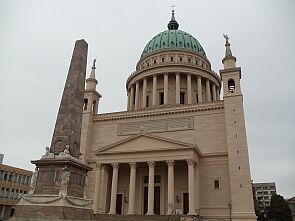 |
During our 2010 visit, we did not only get an unobstructed view at the church, we also got to see its interior for the first time.
The paintings inside were created in 1850 by Peter von Cornelius.
 Some of the sculptures inside, created by Christian Daniel Rauch and Johann Gottfried Schadow sustained damage when the dome collapsed in World War II. They were left unchanged as a reminder of the terrors of war. |
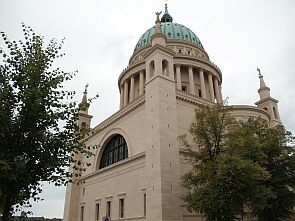
|
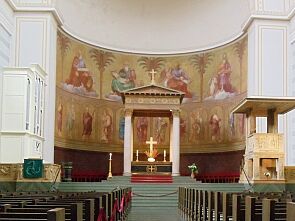 |
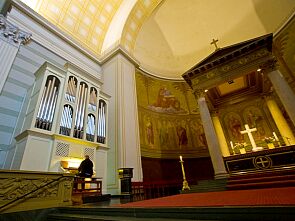 |
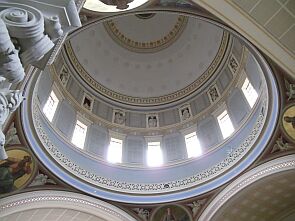
|
| One can actually climb to the dome and get a marvelous view over Potsdam. We dedicated an extra site to these views. |

 |
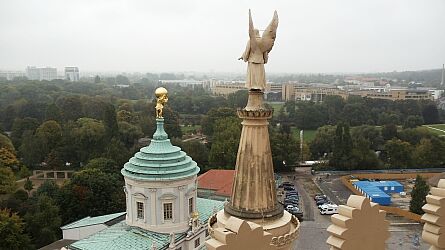
|

 Back to Potsdam Page |
 Back to Home Towns |
 Back to Germany Page |
 Back to English Main Page |
 Back to Start Page |